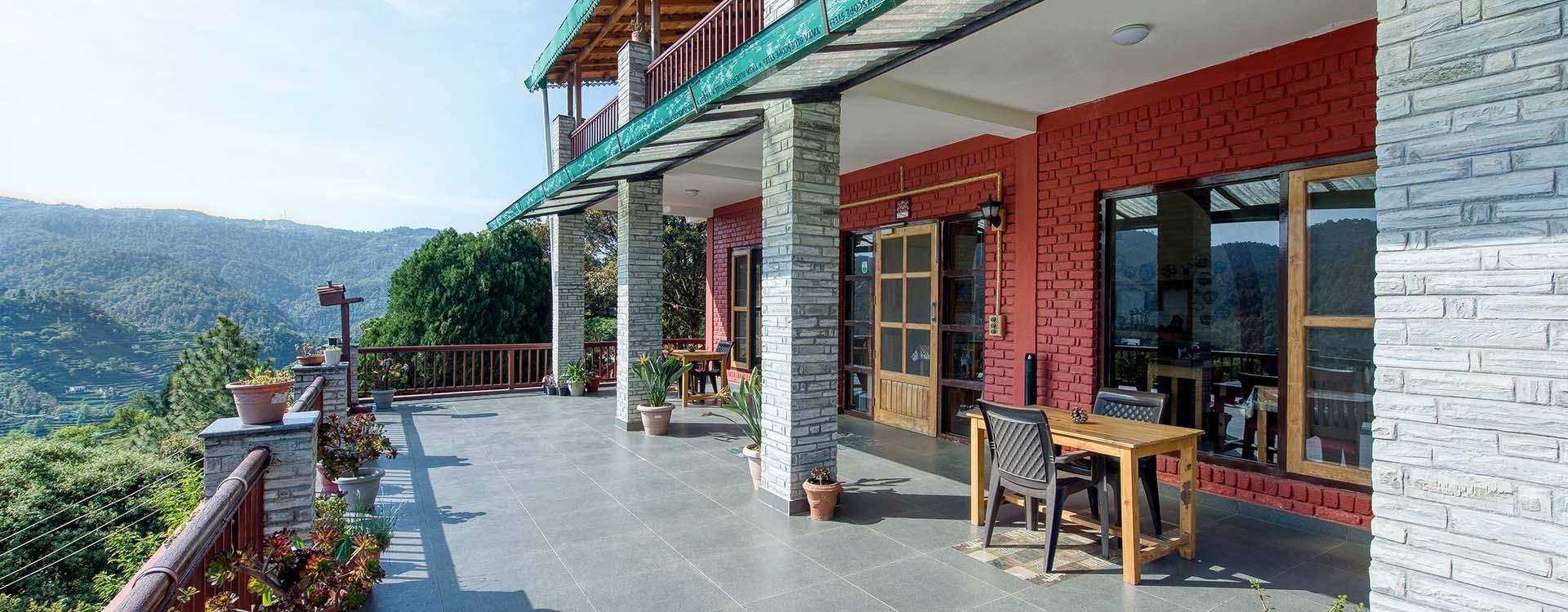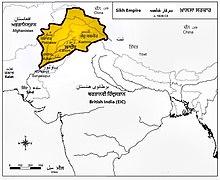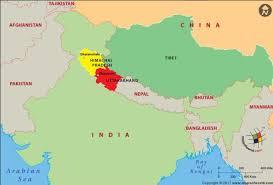Expansion:
In 1802, Ranjit Singh, aged 22, took Amritsar from the Bhangi Sikh misl, paid homage at the Harmandir Sahib temple, which had previously been attacked and desecrated by the invading Afghan army, and announced that he would renovate and rebuild it with marble and gold.
On 1 January 1806, Ranjit Singh signed a treaty with the British officials of the East India Company, in which he agreed that his Sikh forces would not attempt to expand south of the Sutlej river, and the Company agreed that it would not attempt to militarily cross the Sutlej river into the Sikh territory.
In 1807, Ranjit Singh's forces attacked the Muslim ruled Kasur and, after a month of fierce fighting in the Battle of Kasur defeated the Afghan chief Qutb-ud-Din, thus expanding his empire northwest towards Afghanistan. He took Multan in 1818, and the whole Bari Doab came under his rule with that conquest. In 1819, he successfully defeated the Afghan Sunni Muslim rulers and annexed Srinagar and Kashmir, stretching his rule into the north and the Jhelum valley, beyond the foothills of the Himalayas.
The most significant encounters between the Sikhs in the command of the Maharaja and the Afghans were in 1813, 1823, 1834 and in 1837. In 1813, Ranjit Singh's general Dewan Mokham Chand led the Sikh forces against the Afghan forces of Shah Mahmud led by Dost Mohammad Khan. The Afghans lost their stronghold at Attock in that battle.
In 1813–14, Ranjit Singh's first attempt to expand into Kashmir was foiled by Afghan forces led by General Azim Khan, due to a heavy downpour, the spread of cholera, and poor food supply to his troops.
In 1818, Darbar's forces led by Kharak Singh and Misr Dewan Chand occupied Multan, killing Muzaffar Khan and defeating his forces, leading to the end of Afghan influence in the Punjab.
In July 1818, an army from the Punjab defeated Jabbar Khan, a younger brother of governor of Kashmir Azim Khan, and acquired Kashmir, along with a yearly revenue of Rs seventy lacs. Dewan Moti Ram was appointed governor of Kashmir.
In November 1819, Dost Mohammed accepted the sovereignty of the Maharaja over Peshawar, along with a revenue payment of Rs one lac a year. The Maharaja specifically ordered his forces not to harass or molest any civilian. In 1820 and 1821, Dera Ghazi Khan, Hazara and Mankera, with huge tracts of land between Jhelum and Indus, Singh Sagar Daob, were also annexed. The victories of Kashmir, Peshwar and Multan were celebrated by naming three newborns after them. Prince Kashmira Singh, Peshaura Singh and Prince Multana Singh were born to Daya Kaur and Ratan Kaur, wives of Ranjit Singh.
In 1823, Yusufzai Pashtuns fought the army of Ranjit Sing north of the Kabul River.
In 1834, Mohammed Azim Khan once again marched towards Peshawar with an army of 25,000 Khattak and Yasufzai tribesmen in the name of jihad, to fight against infidels. The Maharaja defeated the forces. Yar Mohammad was pardoned and was reinvested as governor of Peshawar with an annual revenue of Rs one lac ten thousand to Lahore Darbar.
In 1837, the Battle of Jamrud, became the last confrontation between the Sikhs led by him and the Afghans, which displayed the extent of the western boundaries of the Sikh Empire.
On 25 November 1838, the two most powerful armies on the Indian subcontinent assembled in a grand review at Ferozepore as Ranjit Singh, the Maharajah of the Punjab brought out the Dal Khalsa to march alongside the sepoy troops of the East India Company and the British troops in India. In 1838, he agreed to a treaty with the British viceroy Lord Auckland to restore Shah Shoja to the Afghan throne in Kabul. In pursuance of this agreement, the British army of the Indus entered Afghanistan from the south, while Ranjit Singh’s troops went through the Khyber Pass and took part in the victory parade in Kabul.
Expansion:
In 1802, Ranjit Singh, aged 22, took Amritsar from the Bhangi Sikh misl, paid homage at the Harmandir Sahib temple, which had previously been attacked and desecrated by the invading Afghan army, and announced that he would renovate and rebuild it with marble and gold.
On 1 January 1806, Ranjit Singh signed a treaty with the British officials of the East India Company, in which he agreed that his Sikh forces would not attempt to expand south of the Sutlej river, and the Company agreed that it would not attempt to militarily cross the Sutlej river into the Sikh territory.
In 1807, Ranjit Singh's forces attacked the Muslim ruled Kasur and, after a month of fierce fighting in the Battle of Kasur defeated the Afghan chief Qutb-ud-Din, thus expanding his empire northwest towards Afghanistan. He took Multan in 1818, and the whole Bari Doab came under his rule with that conquest. In 1819, he successfully defeated the Afghan Sunni Muslim rulers and annexed Srinagar and Kashmir, stretching his rule into the north and the Jhelum valley, beyond the foothills of the Himalayas.
The most significant encounters between the Sikhs in the command of the Maharaja and the Afghans were in 1813, 1823, 1834 and in 1837. In 1813, Ranjit Singh's general Dewan Mokham Chand led the Sikh forces against the Afghan forces of Shah Mahmud led by Dost Mohammad Khan. The Afghans lost their stronghold at Attock in that battle.
In 1813–14, Ranjit Singh's first attempt to expand into Kashmir was foiled by Afghan forces led by General Azim Khan, due to a heavy downpour, the spread of cholera, and poor food supply to his troops.
In 1818, Darbar's forces led by Kharak Singh and Misr Dewan Chand occupied Multan, killing Muzaffar Khan and defeating his forces, leading to the end of Afghan influence in the Punjab.
In July 1818, an army from the Punjab defeated Jabbar Khan, a younger brother of governor of Kashmir Azim Khan, and acquired Kashmir, along with a yearly revenue of Rs seventy lacs. Dewan Moti Ram was appointed governor of Kashmir.
In November 1819, Dost Mohammed accepted the sovereignty of the Maharaja over Peshawar, along with a revenue payment of Rs one lac a year. The Maharaja specifically ordered his forces not to harass or molest any civilian. In 1820 and 1821, Dera Ghazi Khan, Hazara and Mankera, with huge tracts of land between Jhelum and Indus, Singh Sagar Daob, were also annexed. The victories of Kashmir, Peshwar and Multan were celebrated by naming three newborns after them. Prince Kashmira Singh, Peshaura Singh and Prince Multana Singh were born to Daya Kaur and Ratan Kaur, wives of Ranjit Singh.
In 1823, Yusufzai Pashtuns fought the army of Ranjit Sing north of the Kabul River.
In 1834, Mohammed Azim Khan once again marched towards Peshawar with an army of 25,000 Khattak and Yasufzai tribesmen in the name of jihad, to fight against infidels. The Maharaja defeated the forces. Yar Mohammad was pardoned and was reinvested as governor of Peshawar with an annual revenue of Rs one lac ten thousand to Lahore Darbar.
In 1837, the Battle of Jamrud, became the last confrontation between the Sikhs led by him and the Afghans, which displayed the extent of the western boundaries of the Sikh Empire.
On 25 November 1838, the two most powerful armies on the Indian subcontinent assembled in a grand review at Ferozepore as Ranjit Singh, the Maharajah of the Punjab brought out the Dal Khalsa to march alongside the sepoy troops of the East India Company and the British troops in India. In 1838, he agreed to a treaty with the British viceroy Lord Auckland to restore Shah Shoja to the Afghan throne in Kabul. In pursuance of this agreement, the British army of the Indus entered Afghanistan from the south, while Ranjit Singh’s troops went through the Khyber Pass and took part in the victory parade in Kabul.









